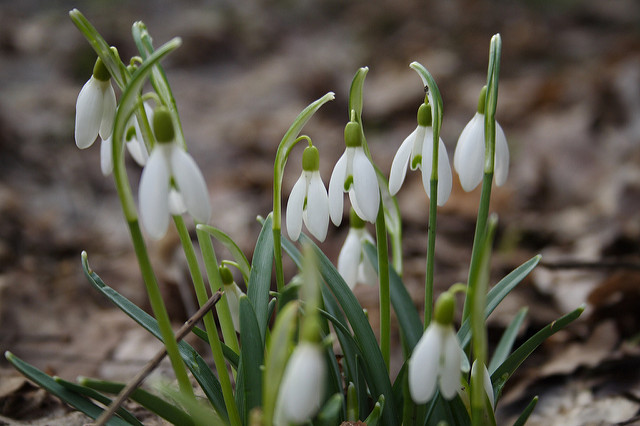Looking out my window this morning it’s hard to believe that just a few days ago I was walking around Audubon looking for fiddleheads and spring buds. Just last weekend I found my first crocuses and snowdrops of the year. Today, those flowers are under a foot of snow.
Finding flowers in bloom at the beginning of March is not uncommon. In fact, if you look up flowers that bloom this time of year you’ll find a half a dozen annual and perennial flowers that emerge throughout the month. That being said, I wouldn’t be surprised at all if we have at least a couple more weeks of snow. I have vivid memories of waking up on my birthday, which falls at the end of the month, and finding a fresh blanket of snow covering the ground.
So why do flowers risk blooming so early? Well, being a flower is difficult no matter when they emerge. Bloom too early and they run the risk of being damaged by frost or covered in snow. Wait too long and chances are the weather will be too hot and too dry for those young plants to survive. For some flowers, emerging in February or March is just the best option.
Surprisingly there are many advantages to blooming in the early spring. In early spring few leaves have emerged from the trees, so flowers on the forest floor are able to collect ample sunlight. Not only are there fewer leaves to shade out the flowers out in early spring, there is less competition for the attention of pollinators. Of course, it’s pretty difficult for a bee to find a flower that is buried under a foot of snow.

Skunk cabbage flowers. Photo by Jeff Tome
While most people think that flowers don’t emerge until the ground is thawed, many flowers will not wait for the lingering snow to melt to start growing. In fact, there is one flower at Audubon that bloomed in February after melting through the ice and snow.
Skunk cabbage is a plant commonly found in wetlands and marshy woods and it gets its name from the skunky smell it produces when it is ripped or punctured. This putrid smell is used to attract pollinators like flies and bees. While this plant is probably best known for its smell, a very interesting thing about skunk cabbage is its ability to produce its own heat, enough heat to melt the snow and ice covering the young plant.
Most spring flowers can’t produce their own heat and must rely on other adaptations to keep them alive when the cold weather hits. By growing close to the ground flowers, like crocuses, take advantage of the heat that has been stored in the soil. When a layer of snow falls the snowy blanket traps that heat between the ground and the snow, protecting the plants and animals underneath.
But what happens when the snow melts and there isn’t anything to protect the flowers from the cold air and frost? Well, scientists have discovered that many spring flowers, including snowdrops, produce a special protein to protect them from the cold. When present, the protein lowers the freezing point of water inside the plant and stops ice crystals from growing in the plant’s cell walls. It acts just like a natural antifreeze.
So, while you were probably worried about what would happen to the flowers that have already bloomed this spring, don’t worry. Spring flowers have special adaptations that allow them to grow through the toughest weather, so keep an eye out for flowers poking up through the snow.
Margaret Foley is a Naturalist at Audubon Community Nature Center.
Audubon Community Nature Center builds and nurtures connections between people and nature. ACNC is located just east of Route 62 between Warren and Jamestown. The trails are open from dawn to dusk as is Liberty, the Bald Eagle. The Nature Center is open from 10 a.m. until 4:30 p.m. daily except Sunday when it opens at 1 p.m. More information can be found online at auduboncnc.org or by calling (716) 569-2345.


Recent Comments